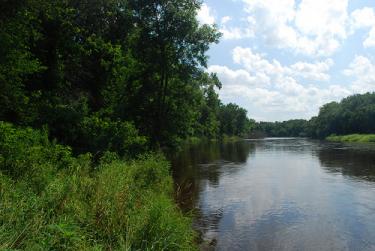How to Care for Rivers
Just like streams, rivers can boost property values and create recreational opportunities. A healthy river can also reduce ground water pollution and protect land against flooding. Unfortunately, many of the country’s rivers are threated by pollution and many man-made “solutions” to flooding have actually done more harm than good.
At the national level and state level, non-profit organizations such as American Rivers, The Nature Conservancy, the Riverkeepers’ network, and various land trusts, are working to protect and restore rivers, wetlands and floodplains by upgrading and removing harmful dams and promoting natural flood protection. At the local level, landowners can take steps to do the same.
strategies TO PRotect Rivers
The three strategies that are used to safeguard and improve the health of streams also benefit rivers. These are: creating and maintaining riparian buffers <link to section in “Streams”>, removing impediments to flow and fish migration <link to section in “Streams”> and road maintenance <link to section in “Streams”>.
In addition to these, you can also do the following:
Organize river cleanups: River cleanups are a systematic effort to remove harmful litter and debris from a river. They are a great way to get up close to a river, monitor its health, celebrate life on the river, and educate family, friends and community about the consequences of damaging river ecology.
Control aquatic invasive species: Aquatic invasive plants and animals, in rivers and along riverbanks, crowd out native species and degrade their habitats. Common shoreline invaders include Japanese knotweed, purple loosestrife, phragmites, hyrdrilla, giant reed and eelgrass. Aquatic invaders include large and smallmouth bass, brown and rainbow trout, carp, stream-choking didymo, Asian clams, Zebra mussels, Eurasian milfoil and more.
Invasives are very difficult to eradicate so the best way to control them is to prevent their spread by checking, cleaning and drying boating and fishing gear. Also, monitor your property using the USDA’s Aquatic Invasive Species database to identify transplants. If you spot intruders, seek technical and financial support for managing invasives from your state through programs such as the USDA’s Wildlife Habitat Improvement Program (WHIP). Control methods may be biological (e.g., insect dispersal), chemical (e.g., herbicides) or mechanical (e.g., harvesting, dredging).
How can I get more tips?
It’s simple! Enter your email below.

